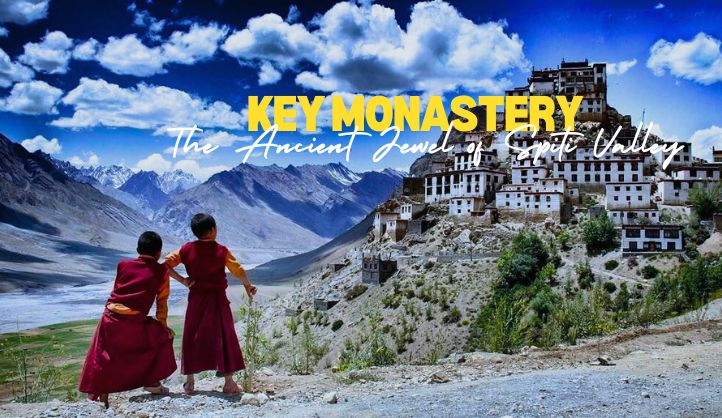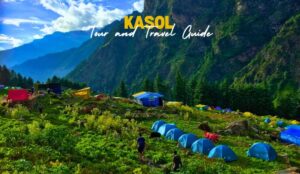High in the majestic Spiti Valley, surrounded by the rugged beauty of the Himalayas, lies Key Monastery, one of India’s most iconic and picturesque monasteries. This ancient Buddhist monastery, also known as Key Gompa or Ki Monastery, serves as both a spiritual sanctuary and a window into the history, culture, and traditions of Tibetan Buddhism. With its stunning architecture, fascinating history, and vibrant community of monks, Key Monastery stands as a symbol of resilience, devotion, and mysticism.
A Brief History of Key Monastery
Key Monastery has a history that stretches back over a thousand years. It was founded in the 11th century by Dromton, a disciple of the famous Buddhist teacher Atisha. Over the centuries, the monastery has witnessed invasions, natural calamities, and even the ravages of time itself. It has been rebuilt multiple times, each reconstruction adding to the unique architectural blend that defines its current form.
Architectural Marvel of the Himalayas
Key Monastery’s architecture is a fusion of ancient Tibetan, Chinese, and Indian influences. The monastery is built in a hilltop fortress style, with tiered structures rising up in a staggered, vertical manner along the hillside. This design, both defensive and symbolic, embodies the monastery’s historic role as a refuge for spiritual seekers, monks, and pilgrims.
Layout and Design
The layout of Key Monastery resembles a labyrinth, with narrow, winding corridors, dark staircases, and small rooms that open into larger prayer halls and courtyards. These rooms house a wealth of artifacts, including ancient murals, scrolls, and statues of deities. Some of the most valuable items are the thangkas—traditional Tibetan paintings of silk or cotton—that depict Buddhist deities and mandalas.
Murals and Thangkas
The monastery’s walls are adorned with murals that depict scenes from Buddhist mythology, teachings, and depictions of the Dalai Lamas. The colorful thangkas, often passed down from generation to generation, hold great religious and historical significance, symbolizing the monastery’s connection to Tibetan Buddhism’s rich artistic heritage.
The Spiritual Life of Key Monastery
Key Monastery is home to a community of around 300 monks who lead a life of discipline, prayer, and study. These monks follow the teachings of the Gelugpa school of Tibetan Buddhism, founded by the revered teacher Je Tsongkhapa, who was also the teacher of the first Dalai Lama.
Daily Routines and Rituals
Life at Key Monastery revolves around a structured routine. Monks begin their day before dawn with prayers, chanting, and meditation. They study ancient texts, practice rituals, and engage in debates to refine their understanding of Buddhist teachings. The chanting ceremonies, accompanied by the sound of horns, drums, and cymbals, create a hypnotic atmosphere that transports visitors into a world of deep spirituality.
Festivals and Celebrations
One of the most anticipated events at Key Monastery is the Cham Festival, held annually in the summer. During this festival, monks perform ritualistic masked dances known as “Cham.” Each dance tells a story from Buddhist teachings, portraying deities, demons, and animals in a vibrant display of color and motion. This festival attracts visitors and pilgrims from all over the world, who come to witness the spiritual and cultural significance of the event.
Key Monastery’s Role in Tibetan Buddhism
Key Monastery is not only a place of worship but also a center of learning and preservation for Tibetan Buddhism. It holds an extensive library of sacred texts, some of which are centuries old. The monastery is affiliated with the Dalai Lama, and over the years, it has played an important role in sustaining the Tibetan Buddhist tradition in India.
A Refuge for the Dalai Lamas
During the 17th century, Key Monastery served as a temporary residence for the Dalai Lama. This connection is still honored today, with the monastery continuing to serve as a place of refuge, education, and spiritual practice for those following the Dalai Lama’s teachings. The monastery’s senior monks have also played a role in transmitting Buddhist teachings to the Spiti Valley and beyond.
Key Monastery: A Photographer’s Paradise
One of the reasons Key Monastery has gained international attention is its breathtaking location. Perched at an elevation of 4,166 meters (13,668 feet), the monastery offers panoramic views of the Spiti River and the surrounding snow-capped mountains.
Sunrise and Sunset at Key Monastery
The best times to capture the beauty of Key Monastery are at sunrise and sunset. The first rays of sunlight transform the entire landscape, casting a golden glow on the ancient walls and the rugged terrain. The sunsets are equally mesmerizing, as the sky turns hues of pink and orange, silhouetting the monastery against the backdrop of the mighty Himalayas.
How to Reach Key Monastery
Reaching Key Monastery is an adventure in itself, requiring a journey through some of the most remote and rugged terrain in India. Here’s a breakdown of how travelers can reach this mystical destination:
By Road
The road journey to Key Monastery usually begins in Manali, Himachal Pradesh. From Manali, travelers can take the scenic route to Kaza, the nearest town to Key Monastery. The journey from Manali to Kaza takes around 8-10 hours, depending on road conditions.
By Air
The closest airport to Key Monastery is Bhuntar Airport near Kullu, approximately 250 kilometers away. From Kullu, travelers can continue their journey by road.
By Train
The nearest major railway station is Shimla, located around 445 kilometers from Kaza. From Shimla, travelers can hire a taxi or take a bus to Kaza, which involves a picturesque drive through the mountains.
Best Time to Visit Key Monastery
The ideal time to visit Key Monastery is between May and October when the weather is relatively mild, and the roads are accessible. During the winter months, heavy snowfall often blocks the roads leading to Spiti Valley, making it nearly impossible for travelers to reach the monastery.
Staying at Key Monastery
For those seeking an immersive experience, the monastery offers simple accommodations for a limited number of visitors. Staying here provides a rare opportunity to witness the daily life of the monks up close. The accommodations are basic, but the hospitality and peaceful surroundings make up for any lack of luxury.
Nearby Places to Explore
1. Kaza
As the largest town in Spiti Valley, Kaza serves as a base for most travelers exploring the region. It offers various amenities such as guesthouses, restaurants, and shops. Here, visitors can experience local Spitian culture, explore the Kaza Monastery, and visit the Kaza Market to buy unique souvenirs and handicrafts.
Kibber Village
Kibber is one of the highest inhabited villages in the world, situated at an altitude of 4,270 meters. Known for its stunning landscapes, traditional Spitian homes, and the Kibber Wildlife Sanctuary, this village is an excellent destination for wildlife enthusiasts hoping to spot species like the snow leopard, blue sheep, and Himalayan ibex.
Langza Village
Famous for its prehistoric marine fossils, Langza Village is often called the “fossil village.” It sits beneath the towering Chau Chau Kang Nilda peak, making it a stunning spot for photography. The village also has a beautiful Buddha statue overlooking the valley, symbolizing peace and tranquility.
Hikkim Village
Hikkim is home to the highest post office in the world, situated at an altitude of around 4,400 meters. Travelers can send postcards from here, making for a unique and memorable souvenir. The journey to Hikkim offers magnificent views of the surrounding mountains.
Komic Village
Known as one of the highest motorable villages in the world, Komic offers serene views, charming local architecture, and the famous Tangyud Monastery. The monastery, with its fortified structure, is believed to date back to the 14th century and provides a rich glimpse into Buddhist culture and teachings.
Dhankar Monastery
Perched on a cliff overlooking the confluence of the Spiti and Pin Rivers, Dhankar Monastery is one of the oldest and most dramatic-looking monasteries in Spiti Valley. The Dhankar Lake, situated about an hour’s trek from the monastery, is also a must-visit for its tranquil beauty and stunning surroundings.
Pin Valley National Park
Known for its breathtaking landscapes and biodiversity, Pin Valley National Park is home to unique flora and fauna, including the elusive snow leopard, Siberian ibex, and Tibetan gazelle. The Pin Valley region is also famous for its beautiful Buddhist gompas and traditional villages.
Tabo Monastery
Often referred to as the “Ajanta of the Himalayas,” Tabo Monastery is over 1,000 years old and is one of the most important Buddhist centers in India. The monastery houses ancient murals, frescoes, and statues, making it an incredible cultural and spiritual site to visit.
Chandratal Lake
Known as the “Lake of the Moon,” Chandratal is a crescent-shaped lake surrounded by mountains. The lake’s pristine blue waters and breathtaking backdrop make it a popular spot for trekkers and photographers. Camping by the lake is a unique experience, especially under the starlit sky.
Losar Village
The last village before crossing into the Kunzum Pass, Losar is an ideal spot for experiencing the local Spitian culture and stunning views of the surrounding valleys. The village’s serene ambiance and unique landscapes make it a peaceful stopover for travelers heading toward Lahaul Valley.
The Role of UNESCO and the Indian Government
While Key Monastery is not currently a UNESCO World Heritage Site, there have been ongoing discussions about its inclusion. The Indian government has also recognized the monastery’s importance and has taken steps to support its preservation through grants and resources.
Tips for Visiting Key Monastery
- Acclimatize Properly: The high altitude can cause altitude sickness. Spend a day in Kaza to acclimatize before visiting Key Monastery.
- Dress Modestly: As a place of worship, it’s important to dress respectfully.
- Ask Permission for Photos: While the exterior is often photographed, some areas within the monastery may have restrictions on photography.
- Respect Local Customs: Be mindful of the monks’ daily routines and avoid disturbing their prayers or meditations.
Conclusion
Key Monastery is much more than just a travel destination; it’s a journey into the heart of Tibetan Buddhism, a testament to ancient architectural brilliance, and a sanctuary of spiritual peace. Visiting this serene monastery provides not only a deeper understanding of Buddhism but also a profound appreciation of the resilience and devotion that has sustained it through centuries. Whether you’re a seeker, a traveler, or a lover of history, Key Monastery offers an experience that stays with you long after you leave its hallowed halls.





